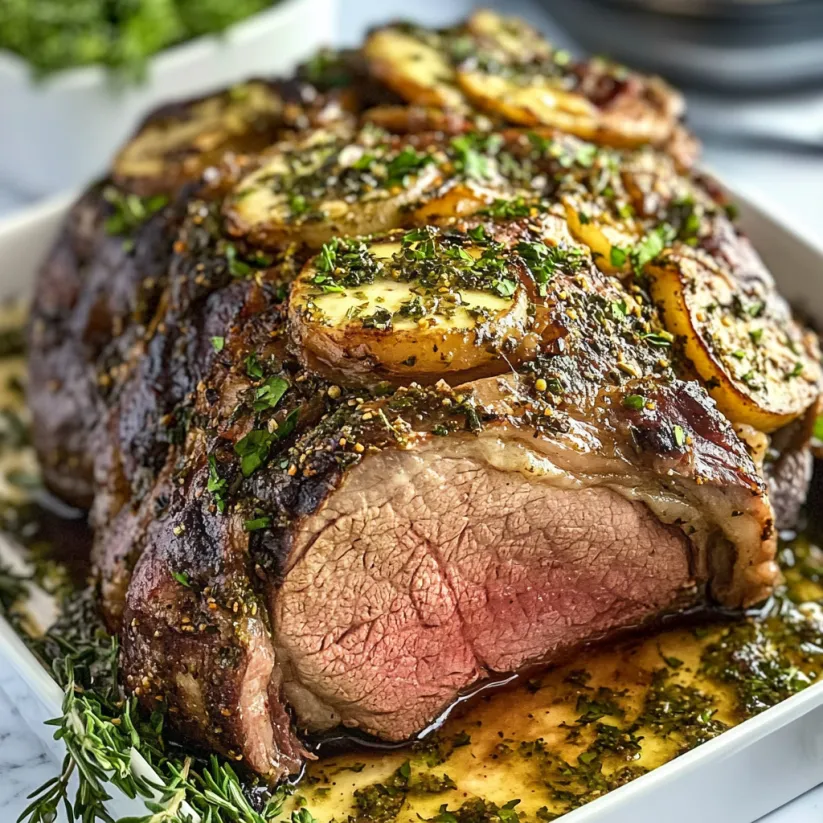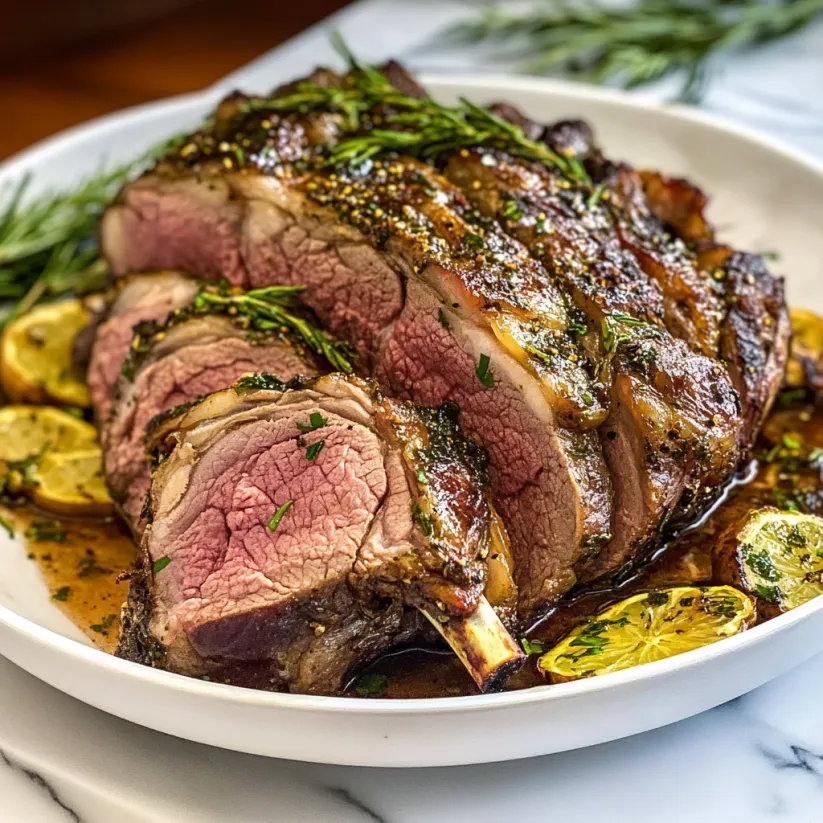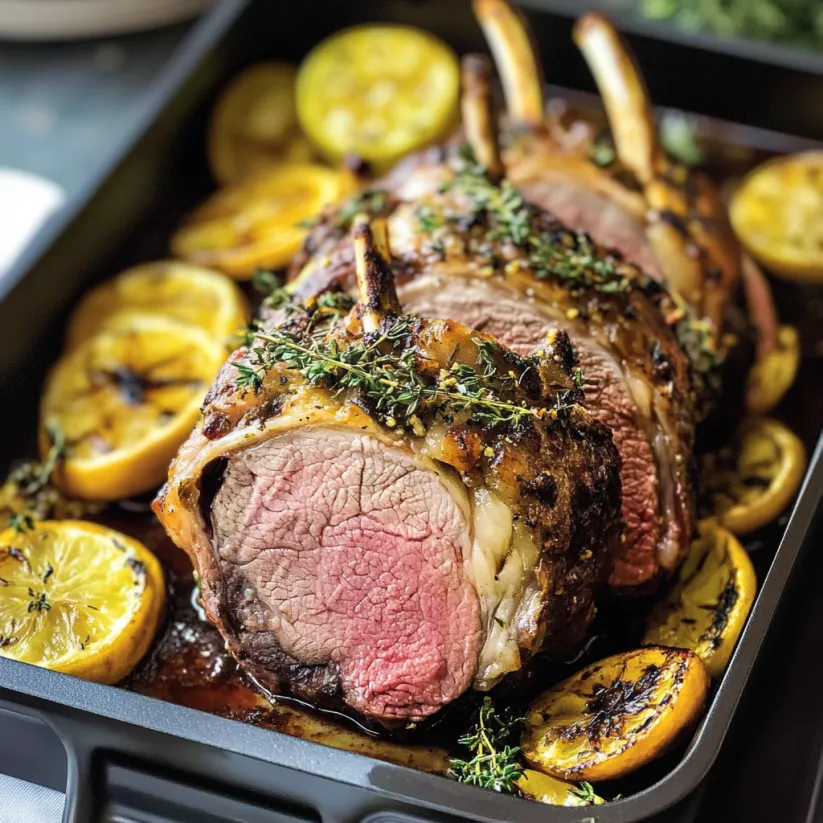 Save Pin
Save Pin
This Italian Marinated Leg of Lamb has been my culinary masterpiece for special family gatherings and holiday celebrations for years. The aromatic Italian herbs and garlic infuse the meat with incredible flavor while the slow roasting process ensures a juicy interior with perfectly crispy edges.
I first prepared this lamb for my parents' anniversary dinner after learning the technique from an Italian chef during my travels through Tuscany. The combination of balsamic, garlic and fresh herbs transported everyone at the table to the Italian countryside, and it has remained our celebration meal of choice ever since.
Ingredients
- Leg of lamb 4 to 5 pounds bone in or boneless. The bone adds tremendous flavor but boneless offers easier carving and more even cooking.
- Extra virgin olive oil provides the base for our marinade. Use a good quality oil for this special occasion dish.
- Balsamic vinegar adds depth and tangy sweetness. Traditional aged balsamic creates the most complex flavor.
- Fresh garlic cloves supply unmistakable aromatic punch. Always use fresh rather than pre minced for best flavor.
- Fresh rosemary and thyme are quintessential Mediterranean herbs that complement lamb perfectly. Their woody aroma is worth seeking out fresh herbs.
- Dijon mustard works as an emulsifier while adding subtle tang. French Dijon offers the smoothest flavor.
- Honey balances acidity with gentle sweetness. Local raw honey provides the best flavor.
- Lemon zest and juice brighten all the flavors. Always use fresh lemons and zest before juicing.
- Red pepper flakes add a pleasant subtle heat. Adjust according to your preference for spice.
Step-by-Step Instructions
- Prepare the marinade
- Combine olive oil and balsamic in a bowl first before adding garlic and herbs. This creates the perfect base texture. Whisk energetically until you achieve a temporary emulsion where the oil and vinegar blend together. Add the remaining seasonings one by one, tasting as you go to ensure balance of flavor. The marinade should coat the back of a spoon with a silky texture.
- Season the lamb
- Pat the lamb completely dry with paper towels before applying marinade. This crucial step ensures the marinade adheres properly to the meat. Season generously with salt and pepper on all sides, pressing the seasonings into the meat. Remember that lamb is a robust meat that can handle substantial seasoning.
- Marinate thoroughly
- Pour the marinade into a large plastic bag or container with the lamb. Massage the marinade into every crevice of the meat, focusing on any natural seams or folds. Refrigerate for at least 4 hours but preferably overnight, turning the meat at least once halfway through to ensure even flavor distribution. The longer marinade time allows the acid to tenderize and the flavors to penetrate deeply.
- Roasting preparation
- Remove lamb from refrigerator at least 30 minutes before cooking to take the chill off. Preheat oven thoroughly to 400°F ensuring even heat. Position rack in lower third of oven for optimal heat circulation. If using boneless lamb, tie with kitchen twine at 1inch intervals to create an even roast that cooks uniformly.
- Initial high heat roasting
- Place lamb on a rack within your roasting pan, allowing air to circulate underneath for even cooking. Begin with high heat roasting to create a flavorful golden crust on the exterior. This step locks in juices and develops complex flavor through caramelization. Watch carefully during this phase to prevent over browning.
- Low and slow finish
- Reduce temperature after initial browning phase and continue cooking at 350°F. This gentler heat allows the interior to cook evenly without drying out. Calculate approximately 2025 minutes per pound for medium rare results, but always rely on a thermometer for precision. Baste occasionally with pan juices to maintain moisture.
- Resting period
- Transfer finished lamb to a cutting board and tent loosely with foil. This critical resting period allows juices to redistribute throughout the meat rather than running out when sliced. Use this time to prepare gravy from the pan drippings if desired. The internal temperature will rise 510 degrees during resting.
 Save Pin
Save Pin
The first time I served this lamb was for my brother's homecoming after two years abroad. As I carried the beautifully browned roast to the table, the aroma of herbs and garlic filled the room. Everyone fell silent as I sliced into the perfectly pink center, revealing juices that pooled onto the platter. That moment of culinary triumph sparked my passion for creating special occasion meals that bring loved ones together.
The Best Internal Temperature
Achieving the perfect doneness for lamb is essential for maximum enjoyment. For rare lamb, aim for an internal temperature of 125°F which will rise to about 130°F during resting. Medium rare, which most chefs consider ideal for leg of lamb, should register at 135°F and will climb to approximately 140°F. For those who prefer medium, remove the lamb at 145°F. Remember that the thinner end of the leg will cook faster than the thicker portion, naturally providing some variety in doneness to please different preferences at your table.
Serving Suggestions
Creating a complete Italian inspired feast around this lamb elevates the entire dining experience. Roasted rosemary potatoes make an excellent accompaniment, especially when cooked in the same pan during the last hour of roasting to absorb the flavorful drippings. A simple arugula salad with lemon vinaigrette provides a peppery, bright contrast to the rich meat. For a truly special presentation, surround the sliced lamb with grilled vegetables drizzled with the same balsamic used in the marinade. Finish the plate with a scattering of fresh herbs and grilled lemon halves for both visual appeal and a burst of brightness.
Make Ahead Options
This recipe is designed with entertainment in mind. The marinade can be prepared up to three days in advance and stored in an airtight container in the refrigerator. The lamb itself can marinate for 24 hours, intensifying the flavor profile significantly. After cooking, the lamb can rest at room temperature for up to 45 minutes before serving, making it ideal for dinner parties where timing can be unpredictable. The lamb can even be roasted earlier in the day, tented loosely, and served at room temperature Mediterranean style, which many consider the optimal way to appreciate its full flavor.
Leftover Transformation
Transform yesterday's elegant roast into today's quick and satisfying meals. Thinly sliced cold lamb makes extraordinary sandwiches on ciabatta with arugula, roasted red peppers, and a smear of the leftover marinade mixed with mayonnaise. For a hearty pasta dish, chop leftover lamb and toss with orecchiette, sautéed cherry tomatoes, and fresh basil. My favorite reimagining is a Mediterranean salad with couscous, diced lamb, cucumber, feta cheese, and a simple olive oil dressing. The flavors actually develop further after a day in the refrigerator, making leftovers something to look forward to.
 Save Pin
Save Pin
Commonly Asked Questions
- → How long should I marinate the leg of lamb?
For best results, marinate the leg of lamb for at least 4 hours, but preferably overnight (8-12 hours). This longer marination allows the flavors from the herbs, garlic, and balsamic vinegar to penetrate deeply into the meat, resulting in a more flavorful finished dish.
- → What internal temperature should I cook the lamb to?
For medium-rare lamb, cook to an internal temperature of 135°F (57°C). For medium, aim for 140-145°F (60-63°C). Always use a meat thermometer inserted into the thickest part of the meat for accuracy, and remember that the temperature will rise 5-10 degrees while resting.
- → Can I use a boneless leg of lamb instead?
Yes, both bone-in and boneless legs of lamb work well with this preparation. If using boneless, consider tying it with kitchen twine to help it cook more evenly. Note that boneless lamb may cook slightly faster than bone-in, so adjust your cooking time accordingly.
- → Why do I need to rest the lamb before slicing?
Resting the lamb for 10-15 minutes after cooking allows the juices to redistribute throughout the meat. If you slice immediately after removing from the oven, those flavorful juices will run out onto your cutting board instead of remaining in the meat, resulting in drier lamb.
- → What sides pair well with this lamb dish?
This Italian-marinated lamb pairs beautifully with Mediterranean-inspired sides like roasted potatoes with rosemary, grilled vegetables, sautéed greens with garlic, or a simple risotto. A fresh salad with bright vinaigrette provides nice contrast to the rich meat.
- → Can I use the leftover marinade as a sauce?
Never use the raw marinade that has been in contact with uncooked meat as a sauce. However, you can make extra marinade separately, reserve it before adding to the raw lamb, and then reduce it in a saucepan to create a complementary sauce for serving.
